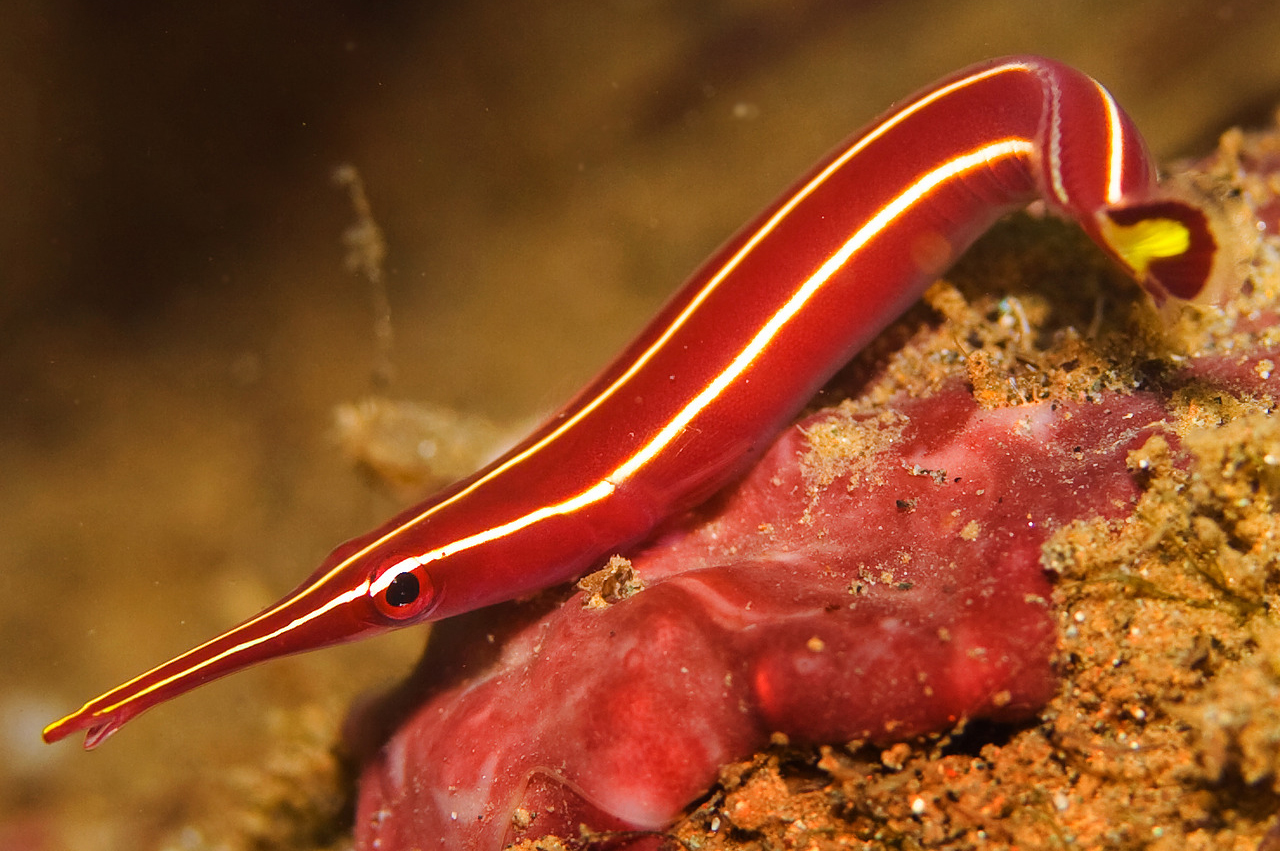Striped Clingfish, Diademichthys lineatus (Sauvage 1883)

A Striped Clingfish, Diademichthys lineatus, in West Papua, Indonesia, depth 25 m. Source: orangkucing / http://orangkucing.tumblr.com/. License: CC by Attribution-ShareAlike
A distinctive reddish to brown clingfish with a yellow to whitish stripe from the tip of the snout to the dorsal fin, a stripe from the upper jaw through the top of the eye almost to the tail base, a yellow spot bordered by a white vertical bar at the tail base and a crescent-shaped reddish to brown mark on the tail.
Striped clingfish are sexually dimorphic in snout shape: females have a long, narrow snout, while males have a rounded snout.
Striped Clingfish, Diademichthys lineatus (Sauvage 1883)
More Info
|
Distribution |
Ningaloo Reef and offshore reefs of Western Australia, and Ashmore Reef, Timor Sea, to the northern part of teh Great Barrier Reef, Queensland. Elsewhere, the species is widespread in the Indo-west Pacific. Shelters among branching corals on sheltered reefs and long-spined sea urchins, Diadema. |
|
Features |
Dorsal fin 13-15; Anal fin 12-14. Striped clingfish are sexually dimorphic in snout shape. Males have a rounded snout; females have a long, narrow snout. |
|
Feeding |
Carnivore - feeds on the tube feet of their host urchins, bivalves that burrow into corals, and on shrimp eggs. Juveniles feed on sea urchin body parts and copepods that live on the sea urchins. Sakashita (1992) found that adult females, having a longer snout consumed shrimp eggs and bivalve molluscs more frequently than the adult males, which fed more frequently on the tube feet of the host. |
|
Biology |
Post larval Striped Clingfish settle out onto long-spined sea urchins at about 10 mm SL, and shelter within the spines until they reach a length of about 20 mm SL. The tiny juveniles hover amongst the spines during the day, picking food from the surface of their host urchin. At night they sleep on sea urchin spines (Sakashita 1992). Larger fish move between urchins and branching corals, feeding on bivalves and crustaceans living amongst their hosts. Individuals larger than 30 mm SL usually sleep in an empty bivalve shell each night. Males guard the developing eggs in a nest. |
|
Conservation |
|
|
Species Citation |
Crepidogaster lineatum Sauvage, 1883, Bull. Soc. Philomath. Paris 7 7: 158. Type locality: New Caledonia. |
|
Author |
Bray, D.J. 2018 |
|
Resources |
Striped Clingfish, Diademichthys lineatus (Sauvage 1883)
References
Allen, G.R. 1985. Fishes of Western Australia. Book 9. pp.2207-2534 526 pls in Burgess, W.E. & Axelrod, H.R. (eds). Pacific Marine Fishes. Neptune, New Jersey : T.F.H. Publications.
Allen, G.R. 1993. Fishes of Ashmore Reef and Cartier Island. Records of the Western Australian Museum, Supplement 44: 67-91.
Allen, G.R. 1997. Marine Fishes of Tropical Australia and South-east Asia. Perth : Western Australian Museum 292 pp. 106 pls.
Allen, G.R. & Russell, B.C. 1986. Part VII Fishes. pp. 79-103 in Berry, P.F. (ed.) Faunal Surveys of the Rowley Shoals, Scott Reef and Seringapatam Reef, northwestern Australia. Records of the Western Australian Museum, Supplement 25: 1-106
Allen, G.R. & Starck, W.A. II. 1973. Notes on the ecology, zoogeography, and coloration of the gobiesocid clingfishes, Lepadichthys caritus Briggs and Diademichthys lineatus (Sauvage). Proc. Linn. Soc. N . S . W. 98: 95-97.
Allen, G.R. & Swainston, R. 1988. The Marine Fishes of North-Western Australia. A field guide for anglers and divers. Perth, WA : Western Australian Museum vi 201 pp., 70 pls.
Briggs, J.C. 1955. A monograph of the clingfishes (order Xenopterygii). Stanford Ichthyological Bulletin 6: 1-224 figs 1-114.
Hori, K., N. Fusetani, K. Hashimoto, K. Aida & J.E. Randall. 1979. Occurrence of a gramistine-like mucous toxin in the clingfish Diademichthys lineatus. Toxicon 17: 418-424.
Kuiter, R.H. 1992. Tropical Reef-Fishes of the Western Pacific, Indonesia and Adjacent Waters. Jakarta : PT Gramedia Pustaka Utama 314 pp. pls.
Kuiter, R.H. 1996. Guide to Sea Fishes of Australia. A comprehensive reference for divers and fishermen. Sydney, NSW, Australia : New Holland Publishers xvii, 434 pp.
Oku (Sakashita), H. 1989. Reproductive biology and food habits of the clingfish, Diademichthys lineatus, associated with diadematid urchins. M.S. Thesis, University of the Ryukyus, Okinawa. 43 pp.
Oku (Sakashita), H. 1990. Reproductive biology of the clingfish, Diademichthys lineatus (Pisces : Gobiesocidae) . Research Student Thesis, University of the Ryukyus, Okinawa. 30 pp. (In Japanese).
Okuno, R., M. Nishiguchi & T. Kurio. 1962. Underwater observations of reef fishes with reference to their micro-habitats and behaviours. II. 2. Doryrhamphus sp., 3. Diademichthys lineatus, 3. Stenopus hispidus. J. Japan. Assoc. Zool. Gardens Aquarium 3(1-2): 16-17. (In Japanese).
Pfaff, J.R. 1942. On a new genus and species of the family Gobiesocidae from the Indian Ocean, with observations on sexual dimorphism in the Gobiesocidae and on the connection of certain gobiesocids with echinids. Videnskabelige Meddelelser fra Dansk Naturhistorisk Forening i Kjøbenhavn 105: 413-422 figs 1-3 pl. 3. (as Diademichthys diversor)
Randall, J.E., Allen, G.R. & Steene, R. 1990. Fishes of the Great Barrier Reef and Coral Sea. Bathurst : Crawford House Press 507 pp. figs.
Randall, J.E., Allen, G.R. & Steene, R. 1997. Fishes of the Great Barrier Reef and Coral Sea. Bathurst : Crawford House Press 557 pp. figs.
Russell, B.C., Larson, H.K., Hutchins, J.B. & Allen, G.R. 2005. Reef fishes of the Sahul Shelf. The Beagle, Records of the Museums and Art Galleries of the Northern Territory Supplement 1 2005: 83-105
Sakashita, H., 1992. Sexual dimorphism and food habits of the clingfish, Diademichthys lineatus, and its dependence on host sea urchin.Environmental Biology of Fishes 34: 95-101. DOI https://doi.org/10.1007/BF00004787 Abstract
Sauvage, H.E. 1883. Descriptions de quelques poissons de la collection du Muséum d'Histoire Naturelle. Bulletin de la Société Philomathique de Paris 7 7: 156-161.
Smith-Vaniz, W.F. & Carpenter, K.E. 2016. Diademichthys lineatus (errata version published in 2017). The IUCN Red List of Threatened Species 2016: e.T67904147A115447579. http://dx.doi.org/10.2305/IUCN.UK.2016-3.RLTS.T67904147A67906400.en. Downloaded on 03 May 2018.
Whitley, G.P. 1950. Clingfishes. Australian Museum Magazine 10(4): 124-128 4 figs






